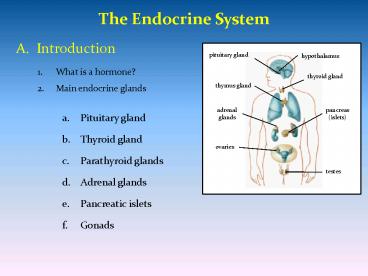The Endocrine System - PowerPoint PPT Presentation
1 / 15
Title:
The Endocrine System
Description:
B. Review of structure and function. Controlled by the hypothalamus ... Clinical features. Ketosis as a result of excessive lipid use for energy production ... – PowerPoint PPT presentation
Number of Views:292
Avg rating:3.0/5.0
Title: The Endocrine System
1
The Endocrine System
A. Introduction
hypothalamus
- What is a hormone?
- Main endocrine glands
- Pituitary gland
- Thyroid gland
- Parathyroid glands
- Adrenal glands
- Pancreatic islets
- Gonads
2
The Endocrine System
A. Introduction
- Endocrine vs. exocrine
- What is a target cell?
- Negative feedback control
3
The Endocrine System
B. Review of structure and function
- Pituitary gland
- Controlled by the hypothalamus
- Infundibulum
- Posterior pituitary gland (neurohypophysis)
- Oxytocin
- Anti-diuretic hormone (ADH)
4
The Endocrine System
B. Review of structure and function
- Pituitary gland
d. Anterior pituitary gland (adenohypophysis)
- Growth hormone (GH)
- Thyroid-stimulating hormone (TSH)
- Adrenocorticotrophic hormone (ACTH)
- Follicle-stimulating hormone (FSH)
- Luteinizing hormone (LH)
- Prolactin (PRL)
5
The Endocrine System
B. Review of structure and function
2. Thyroid gland
- Follicles
- Follicular cells
- Tetraiodothyronine (thyroxine, T4)
- Triiodothyronine (T3)
c. Parafollicular cells
- Calcitonin
6
The Endocrine System
B. Review of structure and function
3. Parathyroid glands
- Parathyroid hormone (PTH)
4. Adrenal glands
- Adrenal medulla
- Norepinephrine and epinephrine
- Fight-or-flight
b. Adrenal cortex
- Minheralocorticoids (aldosteorne)
- Glucocorticoids (cortisol, hydrocortisone)
- Gonadocorticoids (estrogens and androgens)
7
The Endocrine System
B. Review of structure and function
5. Pancreatic islets
- Insulin
- Glucagon
- Somatostatin
8
The Endocrine System
C. Age-related changes
- Hormone secretion stays the same, but receptor
numbers on target cells tend to decrease - Pituitary gland minimal changes
- Thyroid gland
- T4 production declines by 50 with very old age,
but blood levels of thyroxine remain normal - Gland atrophies with increased nodule formation
- Basal metabolic rate (BMR) decreases
9
The Endocrine System
C. Age-related changes
4. Parathyroid glands
- No atrophy of glands some fat deposition
- Post-40, PTH levels in women increase, adding to
bone loss problems
5. Adrenal glands
- No atrophy of glands increased fibrous tissue
- Functional capacity isnt loss, but there is a
moderate decline in adrenocortical hormone
secretion - Secretions of adrenal medulla increase with aging
10
The Endocrine System
C. Age-related changes
6. Pancreatic islets
- Generally, no decline in insulin
- Decline in function occurs at target cell level
(reduced response time in glucose tolerance tests)
D. Age-related dysfunctions
- Endocrine disorders are infrequent in old age
- Changes are pathologic rather than age-related
11
The Endocrine System
D. Age-related dysfunctions
3. Diabetes mellitus
- Essential problem glucose does enter body
cells blood become hyperglycemia - Type I (insulin-dependent) deficient secretion
of insulin by islet cells - Type II (noninsulin-dependent) decreased
sensitivity of target cells to insulin (insulin
resistance) - Clinical features
- Ketosis as a result of excessive lipid use for
energy production - Skin ulcers, glaucoma, cataracts, poor peripheral
circulation, retinopathy, neuropathy
12
The Endocrine System
D. Age-related dysfunctions
4. Hypothyroidism
- 5 over age 65 have thyroid hypofunction
- Causes TSH deficiency, radiation therapy,
chronic autoimmune inflammation of the gland,
removal of the gland - Clinical features difficult to diagnose
- Fatigue, depression, mental confusion
- Dry skin, weight gain, constipation
13
The Endocrine System
D. Age-related dysfunctions
5. Stress responses
- What is stress?
- Subtle stresses for the elderly could be social
isolation, loss of spouse, decreased community
status - Activation of the hypothalamo-pituitary-adrenal
axis and sympathetic nervous system leads to - General adaptation syndrome
- Alarm stage
- Resistance stage
- Exhaustion stage
14
GENERAL ADAPTATION SYNDROME
ALARM
RESISTANCE
EXHAUSTION
15
The Endocrine System
E. Take home messages
- Structural changes include atrophy, fibrous and
fatty deposition, but nothing major - Blood levels remain within normal ranges, except
for gonadal hormones - Demand for various hormones changes and target
cell receptors decrease, altering rates of
secretion - No convincing evidence that age-related changes
in endocrine function promote aging - Plenty of evidence that stress promotes aging
end

